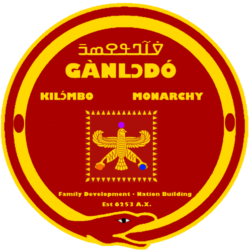Xlɛɛ Gànlɔdó
The Imperial Seal of Gànlɔdó

Colors
Gold – inner spiritual courage, and personal power. It represents that courage and power our ancestors endured for us to even be able to elevate our reality. It represents optimism of family development and nation building and illumination through our culture. For us, yellow is the color of family.
Deep Red – bravery, victory, courage, inner strength, and tenacity, masculinity, spirit; Ṣàngó the co-governing deity of Gànlɔdó.
The combination of the yellow and maroon colors represents the balancing of the feminine and the masculine respectively.
Hɔnsúhɔnsú – Falcon
The falcon is a solar emblem for success, victory and rising above a situation. In relation to the latter, it represents the tenacity and will of the people of Gànlɔdó and their ancestors for rising from the ashes of ignorance, cultural apathy, and captivity to become rulers of their destinies intergenerationally. The falcon is also associated with Ṣàngó for Gànlɔdó. The falcon represents the collective spirit and visionary power of all of the citizens of Gànlɔdó. Hɔnsúhɔnsú represents rulership and royalty. It represents speed, yet efficiency. This is in reference to Gànlɔdó’s commitment to the intergenerational work of nation building and providing, for the people, that which has been lacking in the current practices of Afrikan cultures. The falcon is also loyalty.
It represents the power of forethought and foresight in managing the pace of family development. In this case, it is the pace/speed of forethought and foresight; having the forethought and foresight enough to measure how long certain developmental issues will take in relation to your family. Having such forethought and foresight frees up time, thus speeding up development. It is the hɔnsúhɔnsú’s speed that spells its success.
The hɔnsúhɔnsú carries two orbs in its talons and one on its head. The lavender one on the head represents the Nation Building. The orange represents Family Development, and the blue represents ReAfrikanization. The resilient falcon carries the responsibilities of Family Development and ReAfrikanization while balancing the burden of the nation on its head. This reminds us of the need for balance and carefulness in Nation Building and maintaining the monarchy.
N’ko Writing
Serpent Biting Its Tail
The serpent is Dangbe, or the world serpent, that carried the great mother Nana Bulúkú in its belly. The serpent biting its tail represents the inter-cyclic nature of time and the continual connection between the spirit world and the mundane. It represents our collective ancestry, and is the official animal symbol of Gànlɔdó.
Kilɔmbo
This word is there to remind all that we are a monarchy that strictly follows a Kilɔmbo paradigm at all times. It also happens to be the personal motto of the Gànlɔdóxosu.
Family Development – Nation Building
One of the mottos of Gànlɔdó that reminds us that if we are not doing this then we have no purpose.
Royal Standard of Gànlɔdó

As for the Gànlɔdó flag, one will see the seal with the addition of a sun and crescent moon. In Vodún, the Creator is most often depicted as a complementary of the female represented by the crescent moon, Máwù, and the male represented by the sun, Lisa. Hence, the Creator is called MáwùLisa. This represents that the workings of Gànlɔdó are sanctioned by MáwùLisa. It also represents the commitment that Gànlɔdó has to providing balance between the women and men of our nation, as well as living a spiritual balance between the feminine and masculine spiritual energies. Once again, the two colors, gold and deep red, represent the combining of the feminine and masculine energies. This flag was adopted Zozandagbe, Dedagbè 22, 6258 (Wednesday, January 10, 2018).
The name Gànlɔdó comes from the Fòn phrase “Ye do gan gba jla do dokpo tuto we – Those that broke the chains to restore order”. These are the ones who are rising from the ashes, like the sacred Afrikan Ibis bird, to clear out the rampant chaos, discontent, and lack of empowerment of Afrikan people.
The Official Standards Asyá (Flags) of Vodun
At this time, there are two standards of Gànlɔdó. The first one has the sacred Sekplondo (geometrical symbol in the white area; see the Sekplondo information for the meaning of the red, yeow, and green), official symbol of Vodún, on a standard with four lines meeting at a central point. The latter represents that Vodún is that ancient culture and spiritual system which serves as a meeting point and hub for the various ethnicities and spiritual systems that New Afrikans descend from. Vodún is our most ancient tradition from which all others emanate. It is the flag displayed when unity and immanent war are called for. The sekplondo in the white area represents that Vodún is based in the ancestors and their connection with MawuLisa.

The following standard is is the same but it features a bottle tree. These bottle trees are a Kongo inheritance. The majority of our ancestors, placed in captivity in north America, were of Kongo and Kongo-related heritage. They represent that we are ultimately protected by the spirits of a higher order. These bottles were filled with protective medicines. Colors also played a significant role. This tradition was maintained by those Kongo who were against the horrible business of Afrikan captivity and sold into captivity themselves. In the Americas, they used this science to protect New Afrikan communities and households in addition to passing this on to other Afrikan ethnic groups. The bottle tree reminds us that, though we are of a very ancient stock, we are a New Afrikan people politically, genetically, and spiritually.

